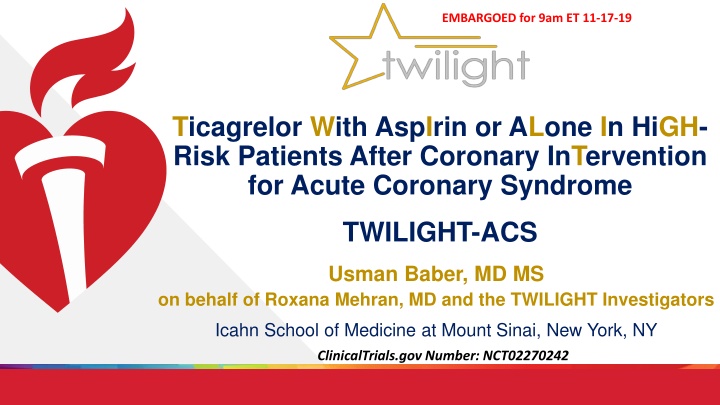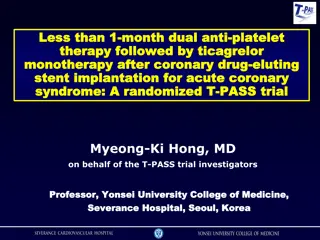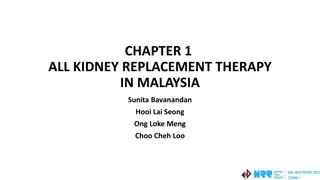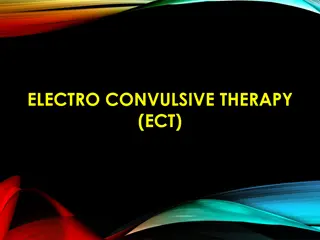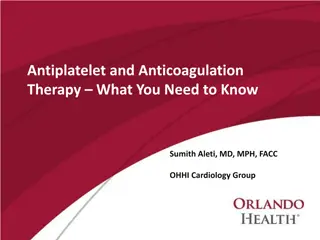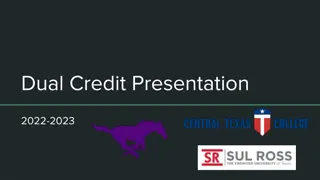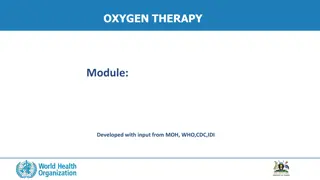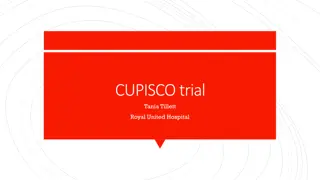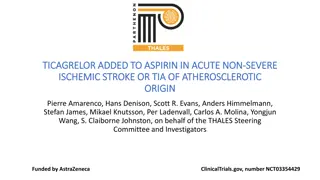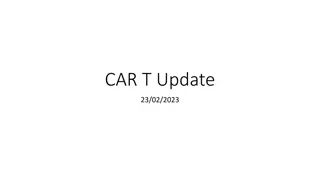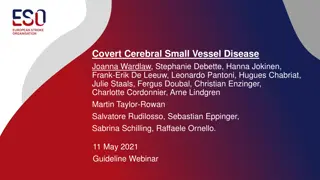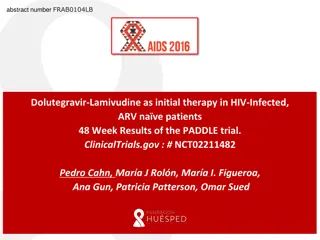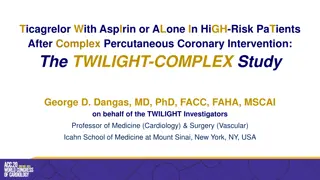Ticagrelor Monotherapy vs. Dual Antiplatelet Therapy in High-Risk Patients with ACS
This study compares the efficacy of ticagrelor monotherapy versus ticagrelor with aspirin in patients with acute coronary syndromes (ACS) after coronary intervention. It investigates the impact on recurrent ischemic events and bleeding risk, focusing on non-ST elevation ACS patients undergoing PCI with drug-eluting stents. The randomized trial aims to provide insights into the optimal antiplatelet therapy regimen for high-risk PCI patients.
Download Presentation

Please find below an Image/Link to download the presentation.
The content on the website is provided AS IS for your information and personal use only. It may not be sold, licensed, or shared on other websites without obtaining consent from the author.If you encounter any issues during the download, it is possible that the publisher has removed the file from their server.
You are allowed to download the files provided on this website for personal or commercial use, subject to the condition that they are used lawfully. All files are the property of their respective owners.
The content on the website is provided AS IS for your information and personal use only. It may not be sold, licensed, or shared on other websites without obtaining consent from the author.
E N D
Presentation Transcript
EMBARGOED for 9am ET 11-17-19 Ticagrelor With AspIrin or ALone In HiGH- Risk Patients After Coronary InTervention for Acute Coronary Syndrome TWILIGHT-ACS Usman Baber, MD MS on behalf of Roxana Mehran, MD and the TWILIGHT Investigators Icahn School of Medicine at Mount Sinai, New York, NY ClinicalTrials.gov Number: NCT02270242
Disclosures Affiliation/Financial Relationship Company Advisory board/personal fees Amgen; AstraZeneca; Boston Scientific Research Funding to Institution AstraZeneca ScientificSessions.org #AHA19
Background The prevailing construct of dual antiplatelet therapy (DAPT) as the preferred treatment for patients with acute coronary syndromes (ACS) originated from clinical trials showing that the addition of an oral P2Y12 inhibitor to aspirin significantly lowers recurrent ischemic events as compared with aspirin alone.1,2 The benefits, or harms, of maintaining aspirin as a long-term component of DAPT in the setting of ACS remains unknown, however, as aspirin served as a background agent in earlier studies. Recent studies have suggested that aspirin-free strategies lower bleeding without increasing ischemic risk as compared with conventional DAPT in select patients undergoing percutaneous coronary intervention (PCI).3,4,5 1Mehta et al., Lancet 2001; 2Levine et al., JACC 2016; 3Mehran et al., NEJM 2019; 4Watanabe et al., JAMA 2019; 5Hahn et al., JAMA 2019 ScientificSessions.org #AHA19
Study Objective To examine the effect of antiplatelet monotherapy with ticagrelor alone versus ticagrelor plus aspirin among patients with non-ST elevation acute coronary syndromes (NSTE-ACS) undergoing PCI with drug eluting stents who had already completed a 3-month course of DAPT ScientificSessions.org #AHA19
Study Design Randomized, double-blind placebo controlled trial in 187 sites and 11 countries High-risk patients underwent PCI and were treated with ticagrelor plus aspirin for 3 months Event-free and adherent patients were randomized to aspirin versus placebo and continued ticagrelor for an additional year High-Risk PCI Patients (N=9006) Ticagrelor + Aspirin Standard of Care Enrolled with NSTE-ACS (N = 5739) ACS= 4614 Ticagrelor + Placebo Standard of Care Enrollment Period 3 Months Randomization Period 12 Months Observation Period 3 Months 3 M 15 M 18 M
Inclusion/Exclusion Criteria Must meet at least one clinical AND one angiographic criterion Clinical criteria Angiographic criteria Age 65 years Multivessel CAD Female gender Target lesion requiring total stent length >30mm Troponin positive ACS Thrombotic target lesion Established vascular disease (previous MI, documented PAD or CAD/PAD revasc) Bifurcation lesion(s) with Medina X,1,1 classification requiring 2 stents DM treated with medications or insulin Left main ( 50%) or proximal LAD ( 70%) lesions CKD (eGFR <60ml/min/1.73m2 or CrCl <60ml/min) Calcified target lesion(s) requiring atherectomy Key Exclusions: STEMI; Salvage PCI; need for chronic oral anticoagulation; planned coronary revascularization ScientificSessions.org #AHA19
TWILIGHT-ACS: Methods Target Population Randomized TWILIGHT participants presenting with unstable angina or non-ST elevation MI (NSTE-ACS) Endpoints Primary: BARC 2, 3 or 5 bleeding between 0 - 12 months after randomization Secondary: Non-fatal MI, stroke or all-cause death between 0 - 12 months after randomization Analytic Approach Survival analyses using the Kaplan-Meier method Hazard ratios and 95% confidence intervals (CI) generated using Cox regression Treatment effect examined in relation to number of clinical and angiographic risk factors Stratified analyses among those with unstable angina or NSTEMI ScientificSessions.org #AHA19
Total Enrolled (N = 9006) Excluded (n = 3267) Clinical Presentation missing (5) Stable Syndrome (3262) Enrolled with NSTE-ACS (N = 5739) Not randomized (n = 1125) Lost to follow-up (76) Adverse events (173) DAPT non-adherence (637) Consent withdrawal/refusal (158) Other reasons (81) Randomized (N = 4614) Unstable Angina (n=2494) NSTEMI (n=2120) Ticagrelor + Placebo (N = 2273) Ticagrelor + Aspirin (N = 2341) 10 withdrew consent 27 lost to follow-up 16 withdrew consent 20 lost to follow-up 15 Month Follow-up (N = 2305; 98.5%) 15 Month Follow-up (N = 2236; 98.4%) Includes 34 deaths Includes 22 deaths 15 M Vital status (N = 2332; 99.6%) 15 M Vital status (N = 2265; 99.6%)
TWILIGHT-ACS: Distribution of Pre-Specified Clinical and Angiographic High-Risk Features 30% 27.5% Proportion of patients 25% 21.9% 21.1% 20% 15% 11.4% 11.3% 10% 4.3% 5% 1.4% 1.0% 0.2% 0% 1 2 3 4 5 6 7 8 9 Number of Clinical and Angiographic High-Risk Features
TWILIGHT-ACS: Patient Characteristics Baseline Demographics Tica + Placebo (n=2273) Tica + Aspirin (n=2341) p-value Variable Age, years [Mean SD] Female sex Nonwhite race BMI, kg/m2 64.2 10.5 25.5% 64.2 10.6 24.8% 0.99 0.56 38.4% 36.5% 0.62 28.4 5.5 28.4 5.7 0.85 35.6% 34.3% 0.36 Diabetes Mellitus Insulin requiring NSTEMI Chronic Kidney Disease Anemia Current Smoker Previous MI Previous PCI Previous CABG 9.7% 10.1% 0.47 45.1% 46.8% 0.23 14.6% 15.1% 0.68 19.9% 19.5% 0.76 23.3% 25.4% 26.6% 25.2% 0.02 0.83 34.2% 8.8% 34.4% 8.5% 0.91 0.68 ScientificSessions.org #AHA19
TWILIGHT-ACS: Patient Characteristics Procedural Details Tica + Placebo (n=2273) Tica + Aspirin (n=2341) p-value Variable 76.7% 76.3% 0.78 Radial access Multivessel CAD Target vessel LAD RCA LCX Number of lesions treated 61.9% 59.5% 0.08 57.7% 58.4% 0.6 34.9% 33.9% 0.47 32.6% 32.9% 0.83 1.5 0.7 1.5 0.7 0.52 Lesion morphology Thrombus Calcification (Moderate/Severe) Any bifurcation 14.9% 15.4% 0.60 12.0% 11.9% 0.92 12.5% 12.6% 0.98 5.6% 6.1% 0.49 0.35 Chronic total occlusion Total stent length 40.5 24.5 39.8 24.6 ScientificSessions.org #AHA19
TWILIGHT-ACS: Adherence by Treatment Allocation Ticagrelor + Placebo Ticagrelor + Aspirin 100 87.8 86.4 Adherence to medication (%) 83.7 82.9 80 60 40 20 0 Ticagrelor Study Drug ScientificSessions.org #AHA19
TWILIGHT-ACS: BARC 2, 3 or 5 Ticagrelor + Placebo Ticagrelor + Aspirin 10% Placebo vs Aspirin HR (95%CI): 0.47 (0.36 to 0.61) p <0.001 8% Cumulative Incidence 7.6% 6% 3.6% 4% 2% 0% 0 60 120 180 240 300 360 Days after randomization Number at risk Ticagrelor plus Aspirin 2338 2285 2240 2197 2160 2129 2095 Ticagrelor plus Placebo 2269 2238 2215 2190 2159 2142 2130
TWILIGHT-ACS: BARC 2, 3 or 5 in Relation to Risk Factor Burden Number of Risk Factors One-year rate (%) Hazard ratio (95% CI) T+P T+A 1 3 (n=1579) 3.5% 7.0% 0.49 (0.31-0.77) 4, 5 3.7% 7.3% 0.50 (0.34-0.72) pint = 0.69 (n=2239) 6 9 (n=796) 3.6% 9.4% 0.37 (0.20-0.68) 0.1 1 10 Ticagrelor monotherapy better Ticagrelor monotherapy worse
TWILIGHT-ACS: Pre-Specified Bleeding Endpoints 4% Ticagrelor + Placebo Ticagrelor + Aspirin One-Year Event Rate, % 3% p = 0.001 p < .0001 2.2% 2.1% p = 0.002 2% 1.6% p = 0.08 1.0% 0.9% 1% 0.8% 0.6% 0.5% 0% BARC 3 or 5 TIMI major GUSTO moderate or severe ISTH major ScientificSessions.org #AHA19
TWILIGHT-ACS: Death, MI or Stroke Ticagrelor + Placebo Ticagrelor + Aspirin 10% Placebo vs Aspirin HR (95%CI): 0.97 (0.74 to 1.28) p = 0.84 8% Cumulative Incidence 6% 4.4% 4.3% 4% 2% 0% 0 60 120 180 240 300 360 Days after randomization Number at risk Ticagrelor plus Aspirin 2338 2208 2292 2169 2242 2223 2201 Ticagrelor plus Placebo 2269 2235 2215 2195 2167 2158 2143
TWILIGHT-ACS: Death, MI or Stroke in Relation to Risk Factor Burden Number of Risk Factors One-year rate (%) Hazard ratio (95% CI) T+P T+A 1 3 (n=1579) 1.9% 3.0% 0.63 (0.33 1.22) 4, 5 4.4% 3.5% 1.27 (0.83 1.93) pint = 0.18 (n=2239) 6 9 (n=796) 8.4% 9.8% 0.86 (0.54 1.36) 0.1 1 10 Ticagrelor monotherapy better Ticagrelor monotherapy worse
TWILIGHT-ACS: Pre-specified Ischemic Endpoints 6% Ticagrelor + Placebo Ticagrelor + Aspirin One-Year Event Rate, % p = 0.77 4.2% 4.0% p = 0.99 4% 3.1% 3.1% p = 0.14 2% 1.5% p = 0.38 p = 0.21 1.0% 0.6% 0.5% 0.4% 0.3% 0% CV Death, MI or Ischemic Stroke All-cause Death MI, any Ischemic Stroke Stent thrombosis (definite/probable) ScientificSessions.org #AHA19
TWILIGHT-ACS: Adjusted Hazards for Death, MI, Stroke HR (95% CI) Variable 1.02 (0.74-1.41) 1.01 (0.99-1.03) 0.92 (0.62-1.36) 1.77 (1.23-2.55) 2.77 (1.94-3.97) 1.38 (0.99-1.93) 1.35 (0.88-2.06) 1.25 (0.86-1.82) 1.30 (0.94-1.81) 1.32 (0.61-2.83) 2.46 (1.19-5.1) 1.09 (0.67-1.77) 0.90 (0.61-1.34) 6.7 (3.1-14.6) Ticagrelor plus Placebo Age, per year increase Female sex Troponin (+) Established vascular disease Diabetes Mellitus Chronic Kidney Disease Multivessel CAD Lesion requiring stent length > 30 mm Bifurcation requiring 2 stents Atherectomy use Thrombotic lesion Left main or LAD lesion BARC type 3 or 5 Bleeding (time-updated covariate) ScientificSessions.org #AHA19
TWILIGHT-ACS: Stratified Analysis According to UA or NSTEMI Ticagrelor + Placebo Ticagrelor + Aspirin pint = 0.90 9% 9% HR (95% CI) 0.47 (0.33-0.68) HR (95% CI) 0.46 (0.31-0.67) pint = 0.33 HR (95% CI) 1.13 (0.75-1.68) HR (95% CI) 0.85 (0.58-1.26) 6% 6% 3% 3% 0% 0% UA NSTEMI UA NSTEMI BARC 2, 3 or 5 Death, MI or Stroke ScientificSessions.org #AHA19
Limitations Extrapolating results to STEMI patients not possible given trial design. Generalizing to broader population of PCI patients without high-risk features pre-specified in TWILIGHT is limited. Use of ticagrelor as background antiplatelet agent thereby precluding inference for other P2Y12 inhibitors. Lack of power to detect differences in the risk of important yet rare clinical events, such as stent thrombosis and stroke. ScientificSessions.org #AHA19
Conclusions Among patients with NSTE-ACS undergoing PCI with DES and who have completed a 3-month course of DAPT with ticagrelor plus aspirin, continued treatment with ticagrelor alone significantly lowers clinically relevant and major bleeding without increasing risk for ischemic events over one year. The effect of ticagrelor monotherapy with respect to bleeding and ischemic events is uniform across different levels of risk. Results are unchanged for patients presenting with UA or NSTEMI. Overall findings are concordant with the results of the primary trial. ScientificSessions.org #AHA19
Acknowledgement We thank all country leaders, investigators, coordinators and study participants who made TWILIGHT possible! ScientificSessions.org #AHA19
Thank you! ScientificSessions.org #AHA19
